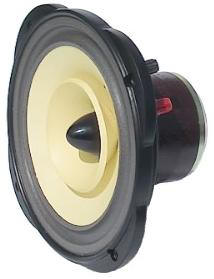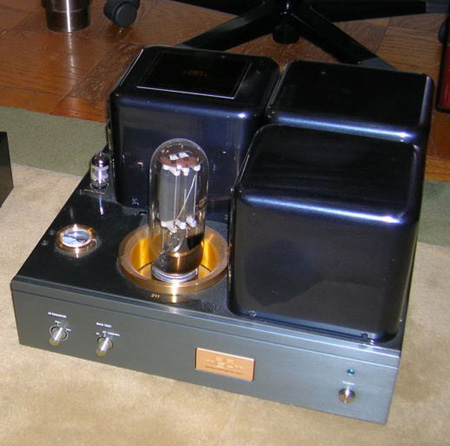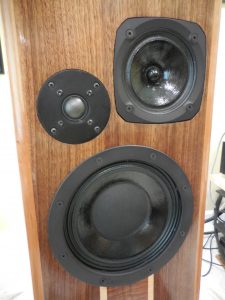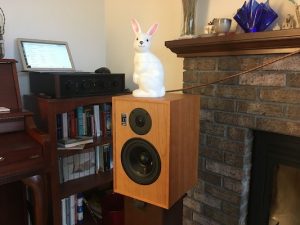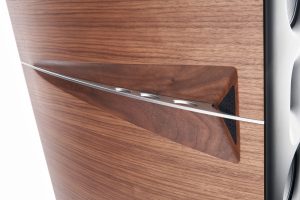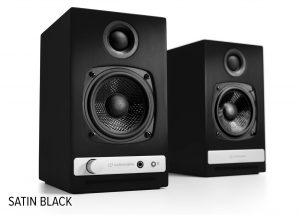This article, by Jeff Silverstein, originally ran when Positive Feedback was in print - Vol. 8, No. 2, 1999.
I miss my Lowther Medallion II loudspeakers. A lot. I had them for a while in 1998 and got to hear some magical sound. Tony Glynn of the Lowther Club of America (he is the Lowther Club of America) is an extremely charming and well-informed gentleman with a great love of the history of audio and a single-minded devotion to this loudspeaker. When Tony and I first began discussing the speakers, the only things I knew about them was they were British, they were a good choice for low powered amplifiers, that Jimi Hendrix used to blow up a lot of them in his listening, and that there is a cult-like devotion to them. What I didn't know about them was how exquisite they sound.
Tony shipped a pair of the Medallion II cabinets and a pair of the PM5A Lowther drivers. The first thing you notice about the Medallion cabinets is the expression on the face of the delivery person as he thinks about whether his health insurance premium is paid up. (They're big and they're heavy.)
Prices come in at $2050. per pair for the cabinets, including shipping, and $1600. per pair for the PM5A drivers. Options include saving about $700. if you want to build and finish the cabinets from a pre-cut kit, or saving about $400. if you want to finish a pre-assembled pair of cabinets. There are a couple of wiring upgrade options available. There's a line of driver choices from the $420. a pair PM6Cs up to the PM5As. (The $1800. a pair PM4As aren't used in these cabinets.) The most common drivers recommended for the Medallions are the $1250. a pair PM2As; in fact the 5s are essentially the same unit with a different and more powerful pole piece. Glynn said the 5s are considered a bit more "aggressive" than the 2s and it's a matter of taste.
The Lowther PM5As are smallish (23.2cm in diameter), they're heavy (6.5kg shipping weight per driver—in cardboard and styrofoam), and there's that funny little second cone and bullet thing in the center. Most of the heaviness is the magnet which is Alcomax3, a special alnico formula. There's an admonition in the instructions to be very careful with the Allen wrench while installing the drivers in the cabinets, lest the magnets wrest them from your grip and hurt the cones. These are powerful magnets. The drivers were amazingly well-made, a pair of powerful British bulldogs which I fantasized if hung from a crane, could lift a Buick.
The second cone has its own single layer voice coil and handles upper midrange. The "bullet" in the center pushes out the highs. Each cabinet is 45"H, 14"W 20 ½" D. It's the depth that makes the cabinets appear massive, but there's a big horn curled up in there. The Medallions are tightly constructed from high quality ¾" birch veneer plywood. The cabinets were finished in hand rubbed lacquer, and Glynn says they'll finish them in "any finish normally obtainable—call for a quote."
Short digression about a situation where size isn't everything. Every male seeing the Medallions said something like "Wow. Cool. What do they sound like?" And invariably each female said something like "Do they really have to be that big?" I'm sure there are some readers who have solved this Venus and Mars issue. Some haven't—I have literally seen twenty thousand dollars worth of source and amplification equipment in one guy's apartment, and seen teeney, squeaky, dinky loudspeakers embedded in a soffit on the opposing wall. When asked about this, my friend sighs and makes the face of that guy in the classic lumpy gravy commercial. ("No lumps... oh no...")
The Medallions aren't mini-monitors. All women certainly do not have issues with large loudspeakers in their homes. The Medallion II cabinets were designed for Lowther Club of America by Jennifer Crock of JENA Labs. They are rear-loaded horns. The bass frequencies come off the back of the Lowther driver, and the midrange and highs both come coherently from the front of the driver. It kind of looks odd, that "little" driver staring at you from that big box. To be fair, looking at them dead-on the Medallions appear like reasonably sized living room speakers. Black fabric grille cloths are "just for show" and Glynn recommends taking them off for listening and replacing them to protect the voice coils from dust. What's deceptive is how much sound is delivered from these highly efficient speakers with only a couple of watts. Tony says they've been measured from 103-106db efficient. They're also available in 8 or 15 ohm.
I'm told that a substantial part of the magical Lowther sound is due to the lack of crossover and the coherency of timing from a single source. I also think the sound of the Lowthers may have something to do with wood, shellac, and breaking in. One of the first things Tony Glynn told me about the drivers was "these PM5As have about 500 hours on them and are broken in." Folks have told me it takes many months, sometimes a year, for their full potential to come out. When you read any of the literature and lore of these speakers you discover that the British makers contract for special cone paper, a secret recipe of four different species of wood. They also use a special lacquer on the cones, the result of a lot of experimentation, which also needs time to break in. This stuff is right out of the Stradivarius instruction book. Psychoacousticians and instrument makers have endless graphs, charts, scope printouts, and back room debates about secret varnish recipes, and which growth of spruce or maple makes the best sound. And flamenco guitarists all know that older guitars sound better, and if you stop playing one for a while you must break it in all over again. As a musician I kind of liked the idea of a long break-in—it reminded me of the best instruments. This suggested to me the necessity for a gradual and subtle series of adjustments in the voice coils and cones which only musical frequencies played in real-time can accomplish.
But it isn't only cones and lacquer. It's weight, stiffness, and alnico, and refinements of a concept first developed in the early 1930s. I can't tell you what "unbroken-in" drivers sound like. I can however say that over three or four months this pair of 500-hour-milage drivers "opened up," "relaxed," and "got it together." By the time this pair had to be shipped (sob) up to Art Dudley, they probably had another 350 hours on them.
If you ask most audiophiles who haven't heard Lowthers what they're about, you'll likely hear something like "Absolutely no bass. Supposedly magical midrange. They blow out very easily. But there are some people who absolutely swear by them." Well let's review that. Lowthers don't kick out a huge amount of bass, though with the right setup, patient breaking in period, and choice of music, there's quite enough. ("Why sire, there's just as much bass as I intended there to be.") The Medallion II cabinets, correctly spiked to the floor, have quite fine bass, if you're not looking for hard rock, heavy metal, techno- sequencer, or disco level funk. The upside however, is in the bass quality.
Acoustic string bass, particularly plucked in the jazz style, is reproduced with a sense of reality and dare I say it again, a sense of wood, which is quite startling and extraordinary. I'd even venture that the Lowther/Medallion bass is revelatory; what it lacks in boomy firepower it makes up for in exposing subtle detail. You can certainly play hard rock through the Medallions—but a listening group thought the Rolling Stones through them didn't quite make it, while softer James Taylor, Suzanne Vega, and Shawn Colvin, were more comfortable. This doesn't mean the Lowthers don't have slam and punch and dynamic power—they do. For example, Sade's super-tight bass/percussion grooves had no problem at all. Deep, pounding, cardio-erotic—the Medallions gave this material its necessary clarity and kinetic energy.
Some of the tweaking that Lowther enthusiasts do is meant to coax the last decibel of bass out of the cabinets. Some is tuning the midrange, and a whole list of interesting subtleties. You should be aware that Tony Glynn is more of a purist, and usually rejects most tweaks, suggesting that the user first fully break in the drivers, and also listen to music that sounds best on the speakers. However, a phone conversation with Jennifer Crock reveals a panoply of tweaks and variations that the designer might have chosen for the release cabinets, or has discovered since. Jennifer is an excellent source of information about these speakers and cabinets, and often disagrees with Glynn. Considering that these two are different ages, have different ears and different musical tastes, it's a wonderful disagreement. I suspect anyone getting into the Lowther world, will ultimately end up on the phone with these two, and other enthusiasts. Oh, and by the way, Tony pronounces it Lowther as in "cow-ther" and Jennifer insists on "snow-ther."
I got quite used to the bass level of these speakers in my living room. My ears grew more accustomed to hearing quality and the subtleties in bass. These speakers, because of their high efficiency, are extremely sensitive to the quality of the signal they get. There was a significant increase in bottom end when I changed the interconnects between the preamp and amplifiers. (I switched to JENA Labs Geminis.) There was also a large difference in tightness and focus between unspiked cabinets and spiked cabinets. These two changes convinced me that were one to go in search of more bass with these speakers, and with the guidance of various wizards, one could squeeze out more.
At the time I had the speakers I also had a pair of Don Garber's transcendent fi 2A3 monoblock amplifiers. 2A3s are often mentioned as just about the perfect tube for these speakers, and among the amplifiers Glynn mentions are Garber's lower-priced X-amp, Ron Wellborne's Moondog 2A3s, and Dan Schmalle's Afterglow. For a preamp, I'd been checking out Wellborne's excellent Reveille tube linestage. Grado's Reference Master cartridge on my vintage AR turntable, a TEAC CD player, and the wonderful Magnum Dynalab Etude FM tuner completed the source. All units were on the superb Mana Acoustics equipment supports, and I was using wire from JENA Labs; Twin 3 speaker wire and Gemini interconnects.
OK, so what do they sound like, and what sounds good on them? Expectedly, classic vinyl from the 50s and 60s sounds good. Forget good, try sublime. I and a number of other listeners sitting in front of the Medallions quickly entered a major trance state. There was a purity of highs, mids, and lows which was completely arresting. I credit Garber's 2A3s with contributing to the magic which I describe as a "poetic" interpretation of the recordings. What I tend to mean by poetic is an intensification of emotion. The metaphor I use is that the system sinks pure silver electrodes into the pleasure centers of the brain. A neural phantasmagoria; a bit of an addictive thing. It would be indelicate to compare this system to a street drug, but if great systems have psychopharmacological impact, I found the Garber/Lowther cocktail did. Crack audiophiles might even consider this their heroine. The system was giving this to me even on recordings I don't particularly like.
The Medallions IIs presented a very wide airy soundstage, and projected image three dimensionally forward to the point where occasionally I could feel sound enveloping my body as opposed to me "watching it" in front of me. It did that in a 16' x 9' room with the speakers 9' apart 2' feet from the long wall. It's true what they say about vocals. Whether it was Chris Conner's Lullaby of Birdland from the 50s or Tracy Chapman's debut album from the 80s—Lowthers are singularly luscious for voice lovers.
One of the things I use as a reality check is percussion, particularly cowbell and timbales. And since I live around the corner from Tito Puente's restaurant, and have heard some of the Latin greats here in the Bronx, I put on some Latin. Here's a record to die for, Puente in Percussion on Tico. Mono, from the 50s, courtesy of Mooncurser Records. This summer I stood 3 or 4 feet from Tito as he played at his 75th birthday party, so I know the sound. The Tico record is just percussion—timbales, congas, cowbells, bongos. Once in a while an acoustic bassline. The Medallions made major mambo. You just start moving. Puente's timbales ricocheted off the inside of the back of my cranium and right down to the coccyx. Another original vinyl Latin gem is Cuban Jam Session in Miniature on Panart. Recorded in the very early 60s in Havana, with Cachao playing bass, there was a voodoo-like sense of after-hours reality, heat, articulation, and a humid wall of tropical sound. I'm not going to say you could smell the cigars and rum... wait a minute, yes I am.
Horns? Like real brass in the room—shimmer, swoop, stutter, shriek, ring, spit, breathe. Clifford Brown with Strings. Art Pepper. Miles. Sonny Rollins. Dizzy. Piano? Randy Weston, Chick Corea, Monk, Hampton Hawes, Billy Taylor—to me, acoustic piano sounded "really real" on the Lowthers, its percussion heritage becoming totally evident. These weren't merely keyboards but hammers and felt and wire and thundering wood.
Classical? Smaller classical ensembles, chamber music, quartets, solo guitar, solo voices, choral, were as lovely as I've heard. Subtleties, delicacies, microdynamics, room acoustics and overtones are what these speakers do brilliantly. Full blown orchestral stuff, Living Presences, Living Stereos, while damn good at room-listening levels, were stretching some for the low end. There is a difference between a single plucked jazz bass and "massed" bass and strings. My configuration with the Lowthers didn't do the orchestral bottom on some recordings as deciballistically as I've ever heard, but you're in such a trance, who cares? I will however say that on some Bernard Hermann tracks the combination of dynamic range, realistic image and transient speediness generated an entry in my notebook "I was viscerally scared." Horns were startling, strings were rosiny spruce, maple and varnish, and percussion was fast and precise.
Contemporary CDs? How about a home-made Lilith Fair? Medallions are made for voice, guitar and careful tight production. Shawn Colvin's A Few Small Repairs really shined. Sarah McLachlan's Surfacing was very airy and self-consciously seductive. Paula Cole's debut sizzled with innovation. If you don't know Patty Larkin's Perishable Fruit, you should. Amazing acoustic guitar stuff—this system loved it. I don't know what it is about Dar Williams' The End of Summer, but it just blows me away. Well, yes I do know.. it's "just open a vein and let songs pour out."
I also tried the Lowther Medallion IIs with Ron Wellborne's 300B Laurel monoblocks with the blue KRs. They did tend to put more bomp in the bass, and were generally pretty spectacular, but I think the 2A3 match with the Lowthers gives more magic, air, and trance-inducing quality. I also tried a prototype of the $895. Garber fi X 2A3 stereo amp and found it a sparklingly sonorous and cost-effective match for the Lowthers.
I generally agree with a lot of the conventional wisdom about the Lowthers. If you happen to groove on acoustic jazz, small ensembles, vocals, non-power rock, Latin, world music, folk and stuff like that there—with the right amp you will be in acoustic heaven. Oh yeah, the Hendrix story, according to the guitar mags, goes something like—when Jimi was living in London he loved Lowther drivers but was blowing them out with a 30 watt Tandberg amp. Word is his girlfriend was having to get them re-coned every week or so.
Relative to many audiophile-priced speakers the Lowther Medallion IIs are downright bargains. And if they're for your kind of music, I suspect you'll keep them for a long time, making them a steal. Low powered amps are a must. Lowthers and single ended triodes go together like they were born to. You may not be able to tear yourself away. If you prefer Danzig or Ozzy or drive-by-shooting-level car stereo, well then these super-refined British lovelies nestled in their Pacific Northwest horn cabinets are too polite pour vous. I know I could live with them for the kinds of music I listen to.
Beware though. The Lowther Medallion II /2A3 combination isn't for what I'd call "casual listening." It is truly distracting to have a system of this preternatural order on in the other room, even at low levels. Whatever else you're trying to do, invisible forces enter your ears, pull you out of your chair, levitate you in front of the speakers, and whisper "Sit here baby, music's on, you are under my command."




